How to Practice Golf: The Three Critical Steps to a Successful and Permanent Golf Swing Change26/1/2013
 Do you struggle to successfully make changes to your golf swing? If you’re like many motivated amateur and professional golfers striving to improve, you take golf lessons to improve aspects of your golf skills so that the outcome is better shot-making and lower golf scores. When you want to change the relative position of a body part in your golf swing to improve how it performs,the goal is to perform it enough times to develop a consistent and reliable ‘feel’ in your golf swing. Golfers and instructors use the term ‘feel’ a lot when describing the sensation of swinging the golf club a certain way. The feel of your golf stroke describes it motion and direction and technically is referred to as proprioception. Proprioception describes your ability as a golfer to sense the location, orientation and motion of your body parts when you perform a golf stroke. In effect, the feel of your golf stroke is its reality as opposed to say just viewing your golf swing on a computer screen where you are actually detached from the feeling of the swing motion you’re viewing. In our experience working with thousands of golfers over the years there’s one thing that Dave and I have become pretty sure about. Many golfers spend more time 'looking' at perfecting their swing motion rather than developing it into a recognizable 'feel' that they can confidently repeat and compete with. It is really important that you understand this key distinction in learning if you want to improve your golf skills in a timely fashion.  Feel Without Form is Fickle All golf stroke change must lead to a recognizable feel that is separate from the actual look of the stroke. What I mean is that it is pointless perfecting the look of your golf swing if you cannot translate that into a feel that you can take to the golf course and perform it with a high degree of trust. If you think that trust is a mental skill, you are barking up the wrong tree! Trusting your golf swing is in-fact trusting the feel of your golf swing. And trusting the feel of your golf swing is the only skill that will keep you on the golf improvement pathway. Here’s where it gets tricky because you have to decide on the priority in learning and developing your golf swing technique if you want to give yourself your best chance of learning it. In other words, what come first? Translate Form Into Feel One of my early golf instructors shared with me a very simple philosophy that really helped me to manage the improvement process. “Feel without form first - leads you on a path to nowhere.” What he was saying to me is that you need to get your mechanical platform or foundation right in your mind first, and then you can practice it to develop the feel sensation that allows you to perform it under pressure. You need to understand clearly how what you are changing is going to lead to improvement. In other words you don’t make a change if you don’t understand it first. Many golfers have been down the path of attempting changes in the golf swing technique but because they didn't understand it well enough they couldn't develop the recognizable feel that you ultimately rely on when you perform. 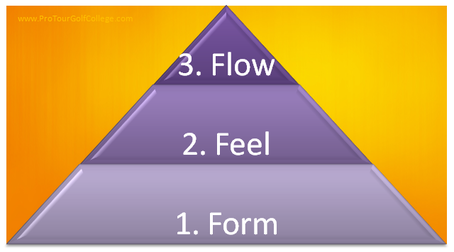 Transfer Feel Into Flow If you don’t understand what you’re trying to do then how can you develop feel and then turn it into flow? Feel into flow is the top of the pyramid in terms of golf swing performance, where you no longer recognize the feel of your golf swing as you have habituated it to such an extent that your golf swing technique flows like a river, smoothly and consistently without conscious thought. At Pro Tour Golf College we describe it with a simple three step approach to help our students to understand the golf stroke change process: Develop the correct FORM – Turn it into a recognizable FEEL - Then let it FLOW Therefore the goal of golf swing change is to develop flow from feel and feel from form. And the best type of feel you can develop is based on a sound mechanical foundation. When you want to make a change to your golf technique from a putt through to a full swing do what the late Stephen Covey suggested as one of his habits in his famous book “The 7 Habit’s of Highly Effective People” and begin with the end in mind. What will your golf stroke look like when you have it where you want it to be? Get clarity around the effect you’re aiming at and then break it down into manageable components. Now each part of the stroke needs repetitions correctly applied until a feel is recognized that you can repeat. This ideally begins without a golf ball in front of you. Start by making the change you’re introducing by standing in front of a mirror or window and learn to understand the feel associated with swinging the golf club the way you’re trying to. You do this by repeating the golf swing motion many times each day correctly. This is why it is essential to have the help of a competent golf instructor to guide you in your development process. The golf instructors primary role is to help you to improve your stroke mechanics, and your responsibility is to practice it into a recognizable feel and ultimately into flow. 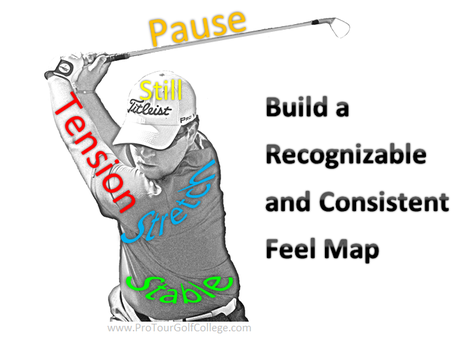 Transfer the Old Feeling Map to the New Feeling Map We explain to our students at Pro Tour Golf College that your feel in your golf swing is just like a map with a starting position and an end position. You job is to practice to develop a very definite pathway (feel) that leads consistently to your destination. You need to understand the layout (form) of your map with checkpoints along the way and also trouble spots. When you practice your feel map, perform the golf stroke very slowly at first to accentuate the correct feel so that you can identify how it differs from your original technique map. At this stage it will not be helpful to include a golf ball in the procedure as the golf ball is a distraction that will slow down your improvement process. This is one of the critical mistakes made by many golfers and even golf instructors. The conscious mind can only focus on one thing at a time and it is enough just to focus on correct swing motion without having to also hit a golf ball successfully. It is a recipe for disaster. With the help of your golf instructor design a specific drill (or use a training aid) that can help you to understand the new feel better. Continually get feedback on how the change is coming along by videoing your swing whilst you perform it in slow motion and then at normal speed. Identify the difference in the two swings and keep adjusting your golf stroke until your old technique is overlaid with the new one. You will never completely lose the old stroke pattern, and at times it might even spring back to life, particularly if you stop practicing your new feel map. There is nothing easy about changing a stroke pattern and it requires consistent application with a sharp focus on performing each repetition as correctly as possible for many months. If you follow the three steps I’m suggesting carefully and spend ample time truly learning to understand the correct feel required to transfer your technique to the flow state then before you know it you’ll be using your new technique and enjoying a higher level of performance and enjoyment for many years to come. Lawrie Montague and David Milne – Pro Tour Golf College Your Success On Tour is Our Business 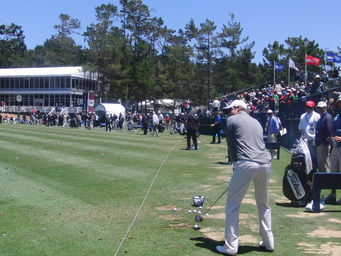 What does a typical week look like for a tournament professional? From the PGA and European Tour's down to the smaller tours how do the professionals organize and prepare to perform at their best? For most of the Pro's with a full tour card they can organize their playing schedule well in advance as they know which tournaments they have automatic entry into and also the courses that would suit their game or where they have had success in the past. The next thing to consider is have they made the 36 hole cut and played the weekend the previous week. For those that have played the full four rounds, Monday is the travel day to arrive and settle in the accommodation that is close to the tournament course. For the players who missed the cut the previous week they would have stayed and practiced on the Saturday and traveled on Sunday to the next venue which means they can get onto the course on Monday and have an extra day to familiarize themselves and do their course charting (mapping the course and putting greens) with their caddy. Now almost all players on the main tour's will have employed a full time caddy that has been working on tour for a few years and has local knowledge and an insight of all courses that host tournaments every year. A good caddy is worth his weight in gold especially when the player gets in contention to win and the caddy can help to make the correct decisions in the heat of battle. The caddy gets remunerated well for this service and on the PGA Tour weekly retainers for caddies start at US$1,500.00 with an added incentive bonus of 6% to 10% when the player makes the cut, finishing in the top ten or winning the tournament.  At every tournament there is some enterprising person (normally an ex caddy) who sells the course charting books for a fee of US $25.00 upwards. On the PGA Tour most of these books are done in yards so either the caddy or player has to adjust it to meters and this can be time consuming. The first thing to do when the player gets to the course is register with the tournament office which some "rookies" in the past have failed to do by Tuesday 5pm and that means they are not included in the draw which goes up after the 5 pm deadline. So if players are playing in the Wednesday Pro-Am which is normally conducted in the afternoon they will plan to get on course in the morning on the Tuesday to get to experience how the course plays under different conditions. One of the big advantages on the main tour's is that every equipment supplier turns up in their trucks and are in attendance to service the players golfing needs on site. From new model clubs, club adjustment and repair, to stocking the players up with golf balls, caps, gloves, shoes and clothing, the players are never short of anything.  The late Ramsay McMaster working with a golfer For those players who are requiring body adjustments or maintenance for injury prevention their is always a section of the locker room that has Physiotherapist or Chiropractors in attendance to work with players. Many top players they will have their personal trainers attend certain weeks of the year to maintain their peak physical conditioning throughout the year. An interesting observation I have noticed at tournaments over the years is that the majority of players who are missing cuts spend most of the week working on their swing at the driving range, and those scoring well are working more on their green-side and putting skills and drills... Some players will work with their coaches on an area of their game that is holding them back, and to get clarity and a plan that will get them back on track and lower their scoring average. Eating well and healthy at tournaments is always a challenge as the food you normally eat is not always available and you have to compromise. Especially young professionals who have to save money by travelling with others to pool their resources and end up at fast food outlets. So my advice to young pro's is to be selective on who you travel with because it may cost you in the long run. Stocking the bag up with supplies of food like fruit and health bars and drinks for hydration is the norm for the modern day player. One last thing to do before Thursday is for the players and caddies to check the weather forecast for the remainder of the week. Being prepared especially for rain and delays is critical to having a successful week. Knowing the direction and change of winds through the day will aid in club selection out on the course. All players will have an early start on Thursday or Friday so having an alarm clock and back up is what nearly every player has to have. I remember Jim Furyk's phone alarm didn't go off as the battery went flat, missed his tee time at the 1st FedEx tournament of 2010 and was disqualified. Mind you he went on to win the FedEx Cup that year and the bonus US $10,000,000.00 that goes with it!  The most successful players are the best prepared week in week out and it starts before they get to the tournament. All the preparation has been done and from Thursday onwards it's about playing golf with a clear mind and focus on the job of putting low scores on the board. The last thing that all successful tour players do is to comprehensively track their practice and playing statistic's so no stone is left unturned to make sure the preperation for the following week and beyond is going to lead them to lower scores. David Milne and Lawrie Montague - Pro Tour Golf College Your Success On Tour is Our Business  A golf handicapping system is a very helpful and indeed useful system for an average golfer that allows them to compete with superior skilled or lesser skilled golfers and was devised primarily to create a level playing field for all golfers so that they can enjoy their game a whole lot more. It would make no sense for an 18 handicap golfer to compete with a scratch handicap golfer “off the stick” as the scratch golfer would win the match’s one hundred percent of the time. However when playing with a handicap the 18 marker has a chance every time he/she plays against the scratch marker to win the match. So a golf handicap is as I said a very helpful system for an average golfer to enjoy their golf. However the golf handicap for an elite level golfer can actually be a big handicap for their ongoing improvement if he/she is considering becoming a professional tour golfer some time in their future. Why? Well, a golf handicap by its very nature adjusts the standard of the golf course to accommodate differences in tee positions, weather and the handicaps of the golfers competing on the day.  Professional golfers don’t have handicaps - they play golf against the par of the golf course whether it is raining, windy, very cold or very hot. So the sooner you can remove the handicap crutch from your game and focus on competing against the par of every golf course you play, the better it will be for you in the long run. The par of the golf course should always be your standard, not your golf handicap. At Pro Tour Golf College we are far more interested in a golfers competitive score average than their handicap. We have worked with countless golfers who claimed to have low handicaps but upon further investigation and analysis of their game we concluded that their actual competitive score average was a lot higher than their handicap suggested. “Part of the reason for this is the ‘throw away’ attitude towards bad rounds that amateur golf fosters. Keep your best cards and throw away the bad ones and you end up with a false representation of your golfing ability.” In professional golf every golf score counts all of the time! So we suggest that if you’re considering playing professional golf or even top level amateur golf then you should start to track your score average for every golf score you produce in tournaments. This means that if you shoot an 85 or worse you have to add it to your collection of golf scores. 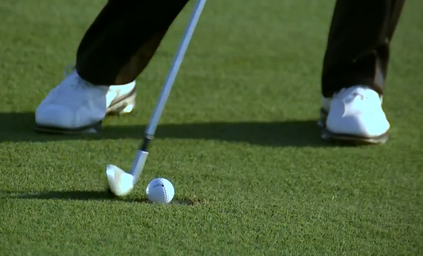 Any golfer can look good if the only scores they post are their best golf scores, and this will be detrimental to your development in the long run. Yes it hurts to shoot scores a lot higher than your expectation, but get over it quickly because that is the nature of competitive golf. In many ways it is the same as golfers preferring their lie when practicing shots. If you always prefer your lie in the bunker and then you’re faced with a half-buried lie in the sand at a crucial time in a tournament, how do you think you would handle it? And the same can be said of golfers who take the ‘gimmee’ offered to them when they play a match with their friends. Hole every putt and never practice the bad habit of not finishing the hole. To post just your good golf scores is setting you up for a big fall. When you are playing in an important tournament and are not playing to your perceived level of expectation it can seriously affect the way you emotionally manage this difficulty. It is so much easier to answer the question “how good are you at golf?’ with the answer “I carry a two handicap,” and yet it doesn’t really tell us much about the golfers actual golfing ability. However, when you are asked the same question and you answer “my competitive score average for my last 20 tournament rounds is 73.6,” I know that you can see the difference in this much more specific answer. It says a whole lot more about your playing ability doesn't it?  One of the unfortunate aspects of the handicapped elite golfer is that when they only submit their best competition cards and enter for a tour qualifying school they will certainly be eligible to play the event with their low handicap, but over the course of the tournament their competitive stroke game will be found out. They soon discover that the ability to shoot consistent low golf scores (a prerequisite for gaining a tour card) is something they won’t be able to do. This happens for more than 80 percent of the amateur golfers competing at a tour school, and the only beneficiaries are the tour schools themselves who rake in plenty of dollars from the entry fees of all these golfers. We advise every student at Pro Tour Golf College that the time to enter a tour school is only when you know beyond doubt that your competitive score average would gain you a card. A golf handicap should never be used as your guide for entering tour school. So when your golf handicap is getting down into single figures (or if it’s already there) this is the time to focus more of your energy on tracking every golf score you produce in the tournaments you play in. Then with the help of your golf coach/instructor devise ways of improving your competitive score average so that when your time comes to enter a tour school, you will give yourself the best opportunity possible of securing one of the available cards. Lawrie Montague and David Milne – Pro Tour Golf College Your Success On Tour is Our Business  When do you start preparing for a career as a tournament professional, and how do you go about it? There is no one pathway, in fact there are numerous ways that someone can develop their golf game to give themselves the best chance to play on a professional tour. The common belief is that unless you are a child prodigy the chances are against you. In-fact the opposite is the case as a mountain of scientific research shows that early specialization in sport and the pressures and injuries that go with it is the main cause of burnout of young golfers as was seen in tennis in the 1980’s and in golf this century. That is why the PGA and LPGA Tour’s now have a strict policy of members having to be 18 years of age before they can play on tour. This is the case for 17 year old Korean Si Woo Kim who attended the PGA Tour School in 2012 won his tour card but is not able to compete until he turns eighteen on June 28th 2013. Unfortunately for him 75% of tournaments will have been played and has to earn the required money to keep his card! Being identified in your County or State program is the most common way to access coaching, funding and opportunity to compete in tournaments and lift your ranking nationally. There are limited spots in the above pathway especially for those who continue to sample other sports, and may have also focused on their education and only starting to specialize around the age of sixteen and have missed being identified. So how does a young golfer find the right mix of education and playing and still compete at a high level before turning professional?  Young golfers like world amateur number 1 New Zealand's Lydia Ko are training and playing full time. That means that she is spending a minimum six hours each day on her golf game and playing in tournaments all year round. So a young golfer attending a regular school and training after school is probably averaging two to three hours a day maximum and will find it difficult if not impossible to compete against someone like Lydia Ko. The option and answer to this challenge is on-line home schooling. Just like most Olympic athletes who train, travel and compete throughout the four year cycle they are enrolled in high school or university studies on-line. This type of option is in my opinion not for ordinary students who benefit with the interaction of children their own age at school. This is for highly self-motivated young people who have the discipline and need the flexibility to train and compete but still maintain an ongoing education, as there are no guarantee’s in sport. Some of these online home school programs are aligned with the US college system so choosing the right program is essential if that is the pathway you decide to choose. The US college system is still regarded as the best pathway for completing a higher education and developing your golf game to be tour ready at the same time. 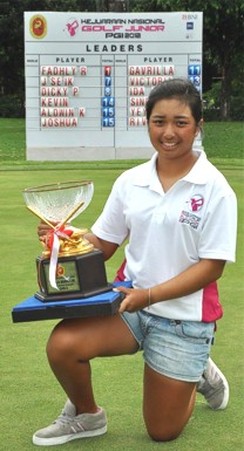 “The preponderance of the available evidence clearly indicates that home schoolers do at least as well as their publicly educated peers on standard academic measures” - Mitchell Stevens, Stanford University education professor and expert on home schooling. In Australia each state has its own requirements for home schooling so it would be advisable to check them out on-line before you make any decisions on whether home schooling is the right choice for you. Home schooling is not for everybody but more and more young golfers around the world are going with this model because it allows them to compete at the highest level to prepare for the tour, and finish their education at the same time. All the extra time this pathway creates to train is wasted if the training is not designed to improve your golf game and get you ready to play on tour. Rather than hoping that your training is leading you to the tour make sure you look out for our new online golf training program being launched in February Hard Core - Elite Golfer Improvement System (See below) which is based on Pro Tour Golf College’s tried and tested golf training program. Here's some links to type into your browser and check out if home schooling is something you're interested in. http://www.homeschoolwa.com.au/?gclid=CJj0z-bR8LQCFWwxpgodMn8Amg http://www.homeschoolacademy.com/homeschool-learning-programs/student-athletes-and-performers/ http://articles.washingtonpost.com/2011-08-09/local/35270395_1_child-athletes-home-schoolers-talented-young-gymnasts David Milne and Lawrie Montague - Pro Tour Golf College Your Success On Tour is Our Business  That is an interesting question as there are literally thousands of elite golfers all around the world who dream of playing golf on tour and yet don’t achieve it. Like all successful elite athletes who sacrifice lifestyle, relationships, getting injured, loneliness, being away from family and friends there is a big price to pay! This weeks article is dedicated to Pro Tour Golf College’s Rance de Grussa who has endured all of the above and more and has finally earned his official Australasian Tour card and is at the starting line in professional golf with the chance to “live his dream.” But let me wind back the clock twelve years ago when Rance and his brother Tim were just starting out. They were junior members at the West Australian Golf Club and later would join Mt Lawley G.C. and their Mum had booked them for golf lessons with me. They were different in their personalities but both showed a strong ability to play the game. Tim went on to win the West Australian Junior Championship and soon after decided that he was going to university and golf would slide down the priority scale in his life. Rance on the other hand was infatuated with the game and after making and then representing the West Australian Junior State Team at the National Championships he decided that golf was going to be his life's pursuit.  He was making good progress in his golf development until an injury to his pelvic and lower back threatened to destroy his dream. For two years and countless medical expert opinions, expensive medical bills and very little golf a frustrated and desperate Rance made an appointment with me to decide what options were left open to him. Although an extremely fit young man from a cardio point of view he had below average awareness and control of his core muscles especially during the downswing causing him to “crunch” his hips under him and toward the ball. This I believed was the main reason he was injuring himself during multiple round tournaments. With the help of the late physio-therapist Ramsay McMaster a program was designed to improve Rance's strength and awareness of his deep core muscles, combined with an improved lower body technique to put Rance on the road to recovery. Within three months he competed in the 36 hole Cottesloe Open and shot two rounds of 70 to finish in the top ten in a field that included some of the best professionals in Australia. Rance continued to keep himself injury free and earned selection in the under 23 year old WA State Team for the National Championship. Unfortunately shortly after playing in the New South Wales Amateur Championship, the week before the Australian Amateur he physically broke down again. Being on the road and away from home he could not get to the gym to maintain his physical program. A tough lesson for him to learn.  Instead of blaming anyone or saying “why me,” he decided as he was rehabilitating that he would do a personal trainers course which would allow him when completed to earn a living. Once fully recovered Rance decided that he had enough of amateur golf and was going to turn professional. He had saved some money, sold his car and with help from his parents he decided he was going to roll the dice and play the mini tours in the USA. Staying with his good friend Michael Sim (PGA Tour player) in Scottsdale Arizona he entered to compete on the Gateway Tour where his entry fee was US $1,100.00 per tournament. With purses of US $60,000 to US $100,000 depending on how many register to play each event it is a very expensive way to find out whether you can cut it as a professional golfer. First he had to get a car to get to the tournaments, so off he goes to the 2nd hand car auctions and buys one for a good price, or so he thought. Unfortunately once he left the yard he could not engage the reverse gear. Taking it back he found out there was a no return policy so he negotiated to sell it back to them at a loss of US $1,000!! A couple of days later he bought another car and this one had reverse gear thrown in! So off he goes to the tournament and coming home on the highway after shooting 74 smoke starts to invade the car followed by flames. Quickly parking the car he jumps out in his golf gear (pink jumper, white trousers, belt and golf shoes) grabs his lunch box and Titleist bag and clubs and watches his second car in a week go up in flames. A fire engine arrives and puts the fire out followed by tow truck that takes Rance and his car back home. Now for the average person this would signal the end of his trip, but not Rance. With more help from his parents and friends he stays and competes until the money runs out. On his return to his hometown of Perth (and to his credit) he goes to work for his dad (to pay as much of the money he owes him back), plus he works part time in a drive through liquor store, and also does his personal training to get himself out of debt. Three jobs! After three months he is on the brink of giving up on his dream of playing on a professional golf tour as he sees his friends with good jobs and driving nice cars. But he is not done, he stops his personal training so that he can start training at Pro Tour Golf College once again three days a week.  At the end of the year he attends the Asian Tour School in Thailand and earns himself a conditional card on the Asian Development Tour. This gets him eight tournaments to play in South East Asia. He plays his first tournament in Malaysia and makes the cut and his 1st pay cheque as a professional, he’s on his way! Then he makes his way to Indonesia and the day before the tournament starts he is struck down with food poisoning and withdraws. Back home it’s back to the two jobs and training as he gets ready for the next tournament. People that he knows inquire why he is still trying to play professionally when the signs show he is not going to make it. This makes him even more determine to succeed. Rance arrives in the Philippines for two Asian Development Tour events and promptly gets sick again and has to be hospitalized for a couple of days which rules him out of the tournaments. So back to Perth and another low point in his life and his golf career After speaking with co-director Lawrie Montague and myself we advised him to stick with his plan and the goals we had put in place as he was showing signs in training that his skills on the golf course were at the level of a tour player but some of his self management skills were not at the same level, which was holding him back. It was in this period that Lawrie and I saw a transformation of Rance de Grussa with clear objectives and goals and that was to gain his tour card at the end of the year. All this focus and single mindedness did not go unrecognised. A sponsor approached Rance to give him the opportunity to train and play full time for 18 months with all expenses taken care of. The result is Rance got through the 1st stage of the Australasian tour school and after a solid start at final stage got caught in 50kph winds on the 2nd day and scraped through the half way 36 hole cut. Two rounds of 71 to finish off, and a tie for 37th gained him his Tour Card. What an amazing and inspiring journey for him just to get to the “starting line” and begin his next chapter as a tour professional. Throughout the journey Rance (to his credit) has always taken complete responsibility for his actions, and has never blamed anybody or anything for the hardship he endured in pursuing his dream of playing on a professional golf tour. I know he acknowledges his parents, his close friends, his sponsor and Pro Tour Golf College for this chance of “living his dream” of being a professional tournament golfer. What a ride it’s been so far, and I'm sure there’s plenty more to come. Are You Willing to “Pay the Price?” Keep an eye out over the next few weeks for our new program "Hard Core- Elite Golfer Improvement System" where we'll show you how to get your game good enough to take it to the pro tour. David Milne and Lawrie Montague - Pro Tour Golf College Your Success On Tour is Our Business How to Practice Golf: The Goal Setting Formula You Need to Know to Become a Successful Golfer11/1/2013
 I’m sure you have heard of the old adage by Chinese philosopher Lao Tsu that go’s “the journey of a thousand leagues (miles) begins with a single step?” What this encourages us to understand is that dreaming about something you want is important, but actually taking the walk towards it is even more advantageous. In golf this is exactly the same. You can dream about becoming a successful amateur or professional golfer as much as you like, but without consistent and thoughtful effort in the most important parts of your game all you have is a good idea and no real way to get to it. And I strongly suggest that if you’re contemplating the achievement of a worthwhile goal, then you’d better have a pretty good idea of where your target is. It’s so easy to get caught up in the repetitions without having a clear idea of what you’re actually doing it for. One of the biggest challenges we all face as golfers is in deciding exactly what we want from our game. This seems to be a continually challenging condition of almost all golfers. And balancing the destination with the route to get there is the key to successfully achieving your goals in golf. Too much of one element in the formula and you’ll more than likely miss hitting your mark. "It’s so easy to get caught up in the repetitions without having a clear idea of what you’re actually doing it for." Golf Goal Setting FormulaBut here’s an important part that is quite often missed when discussing goal achievement. Being dedicated to your goal may be the most challenging aspect of the process. Many golfers start on a journey of change only to fall back into their old and reliable habits. So goal achievement must be driven primarily by your perceived value in the goal and also your ability to actually achieve it. In our opinion goal achievement is hugely influenced by the following important factors; 1. The importance of your goal or outcome 2. Whether you think you can actually achieve it This following formula is the one we use at Pro Tour Golf College with our students which seems to express it pretty well; Dedication to your Goal = Value of your Goal (importance) x Attainment of your Goal (knowing how to get it) You see you have to truly believe that your goal is achievable before you can truly commit yourself totally to it, regardless of how important it may seem. You will be more committed to valuable and achievable goals; however, if the value of your goal or your ability to achieve it becomes low on the level of importance scale, then your dedication to achieve it will soon disappear. Just One Important Goal at a TimeYou see every goal you attempt begins with the thought of what it would be like if you had it, and then whether you believe that you have the ability to achieve it. Therefore the key to achieving your golfing goals is to develop a strong sense of accomplishment over your most important goal. Start with just one important goal at a time. Remember the journey begins with a single step. And the goal will have to be very important to you to maintain the consistency of effort required to achieve it. The goal you choose should be realistic, which means that even with a big stretch you could actually achieve it. Notice I said stretch? There’s a fine line between a goal that helps you and one that hurts you. It will be helpful for you to choose a goal that forces you to operate on the edge of the “uncomfortable zone” which is the space between comfortable and uncomfortable. Remember a little hurt (Stretch) can take you a long way, but a lot of hurt will send you flying backwards. It is very easy to get discouraged and drop your goal if you make it too hard (Hurts) to achieve within a reasonable time frame and the majority of golfers we've worked with tend to stretch to unrealistic zones that put them under the type of pressure that stalls their growth. How to Choose Your Important GoalSo I guess the question that arises is how do you choose your most important goal? Of all the things that you could achieve with your golf in the ensuing year which goal would be the one that would give you the most satisfaction? Is your goal going to be one of these five? 1. Golf stroke improvement goal? 2. Golf shot-making skill goal? 3. Golf score goal? 4. Golf mind improvement goal? 5. Golf body improvement goal? These are the most popular types of goals that golfers look at to decide on the most important one for them. The idea here is that you might need to improve some aspect of your technique to hit better and more consistent shots that would eventually lead to lower golf scores. Or by improving the way you think about your game you could improve your swing, shot or score. Then again if you were more flexible would that help your technique which in-turn helps your shot-making and score? The image below shows a simple way to assess the importance of your golf goal types. Now we know that there are many approaches that you can take to develop your goals but consider that the starting point must be carefully thought out.  In other words you need to look at the cause and effect nature of your golf game carefully to understand which aspect of your game you will decide is the most important part to improve first. Start in the wrong place and you’ll almost certainly take a lot longer to achieve your most important goal. Here's a good question to help you to start in the right direction and decide on the best element of your game to improve first. To reduce my competitive stroke average by 2 shots from 76.3 to 74.3 by November 30 this year the skill that I would need to improve the most to give me my best chance of achieving this goal is ___________________________________ Chunk It DownRemember that the skill/s that you choose to improve will improve your potential for achieving your goal and will be the highest in value (Importance) but also achievable with a stretch. To improve your competitive score average the two strokes of improvement in the following example requires a simple plan to break the 2 strokes down into manageable chunks. If you had 12 months to achieve the goal of 2 strokes improvement then you could easily chunk your goal down into 4 smaller-more manageable sub-goals. To improve your score average by just .5 in 12 weeks will seem a lot easier to achieve than trying to improve 2 strokes over 12 months. It is the same goal just represented differently so you are more motivated to stick with the goal. It is the same principle used by trainers to reduce weight on people. The person may be motivated to lose 20 pounds and the trainer will suggest that this could be achieved by chunking it down to more manageable units. 20 pounds divided by 40 weeks = half a pound a week.  So once you have chunked it down you need to decide on a practice program for actually improving your score average by .5 in 12 weeks. This is where you need to look closely at your practice routines and decide how they will change to lower your average within the specified time period. Remember keep it simple! You don't have to go to outrageous lengths to achieve your 1st sub goal, you just have to manage your effort in such a way that the outcome is very gradual improvement. Which golf skill or skills will have the biggest impact on your golf score average? In your first 12 weeks choose the most important skill/s and practice them 70 percent of the time. What this means is if you chose putting and sand play as the two skills to improve, then design specific practice routines that guarantee that the skill will improve with consistent effort. And if you don't know how to design effective practice routines that lower your golf scores in competition then you will want to join our online program The Elite Golfer Improvement System because we will show you exactly how to build your own personal golf improvement program from the ground up. Do you want to know more about this unique golf improvement program? Click on the image above to find out how this program can help you to reach your performance goals sooner rather than later.
Lawrie Montague and David Milne - Pro Tour Golf College The Professional Golf Tour Training College for Serious Amateur Golfers  When you complete your golf training session how will you know how you did? Will you measure how many shots you hit within the allocated time line? Or possibly, whether you achieved your score goals in the session? These are important parts of a golf training session to evaluate, but I believe there’s one that’s even more important. "The amount of quality training you completed within the allocated training period." When you divide the segment time into the overall time it gives you a value of how much work was performed within the overall training period. I have witnessed many elite golfers who quite frankly waste their time on the practice ground, and have very little to show for it by the end of a practice session.
 In the training session example above, Ben was on the driving range and short game area for three hours and thirteen minutes and he completed two hundred and fifty strokes. Fifty percent of these strokes were training his short game skills, and fifty percent was training his long game skills. His segment time for the three hours and thirteen minutes was one hundred and thirty nine minutes, and between his sets he spent about fifty minutes over the three hours not hitting golf shots. If you divide Ben’s 139 minutes of segment time into 193 minutes total time, you can gain a measure of the percentage of the quality of his training time, it would look like this; 139 ÷ 193 x 100 = 72 %. In my opinion this is an excellent training session because it suggests that Ben went about his work without the common distractions I witness on the golf range that dramatically reduces the effectiveness of it. Ben’s result is two percent above what we call the golden standard (70%) for the qualitative and quantitative measure of your golf training session. Something to think about next time you go to the practice fairway to work on your game. Lawrie Montague and David Milne - Pro Tour Golf College Your Success On Tour is Our Business  After two years as a professional PTGC's Jason Scrivener has earned tour cards to play on four different tours this year. This year Jason has retained his playing privileges on the Australasian and Canadian Tours for 2013. He finished 37th and 58th on the respective Order of Merits and this ranking guarantees him entry to all tournaments on both tours. As a result of his Australasian ranking it opens up the opportunity to play on the lucrative OneAsia Tour where all tournaments have a minimum US$1 Million purses. Jason's fourth tour card is on the European Challenge Tour. This he earned by getting to and playing in the final stage of the European Tour School. Now although all these four tour cards offer opportunity, Jason will sit down with myself (Primary Coach) and his manager Ian Davis (SFX Management Group) to outline which tournaments to play and focus on. This is critical as he could be flying around the world chasing tournaments and burning himself out. So planning his year out using an annual periodisation program enabling his game to develop and peak his game at the main tournaments he chooses is a priority.  Jason turned professional after a successful amateur career where he ranked in the top five in the Australian ranking and was also ranked in the top thirty in the World Amateur Ranking. A former Australian Junior Champion he entered to play in the 2010 PGA Tour School and did not progress past 1st stage. On his return to Australia he gained his Australasian Tour card. What he found out was that the fields in professional tournaments were a lot more competitive then he envisaged. Instead of the ten competitors who could put a score together in amateur tournament there were now fifty or more in the professional tournaments. In the two years that Jason has been a professional one of his main attributes that has allowed him to keep improving is his emotional maturity on and off the course. As my co-director Lawrie Montague defines emotional maturity as "someone who possess the "grit" (determination) factor when they are playing good or bad, and who can also separate themselves from their golf score." In the last year he has made great improvements in both his long game, where he has gained distance off the tee and got his stock shot (fade) back. In his short game he has put more time and emphasis in where now he is seeing his competitive scores improve. An exciting year ahead for Jason Scrivener and the journey to competing successfully on the European or PGA Tour is around the corner. But first he has to serve his "apprenticeship" so that when he does get the opportunity to play on a major tour it will be a long successful career. David Milne and Lawrie Montague - Pro Tour Golf College You Success On Tour is Our Business |
Archives
June 2019
|
||||||
Proudly Supported By
Copyright © 2011 - 2018 Pro Tour Golf College
Website Managed By Golf Performance Media
All Rights Reserved
Website Managed By Golf Performance Media
All Rights Reserved


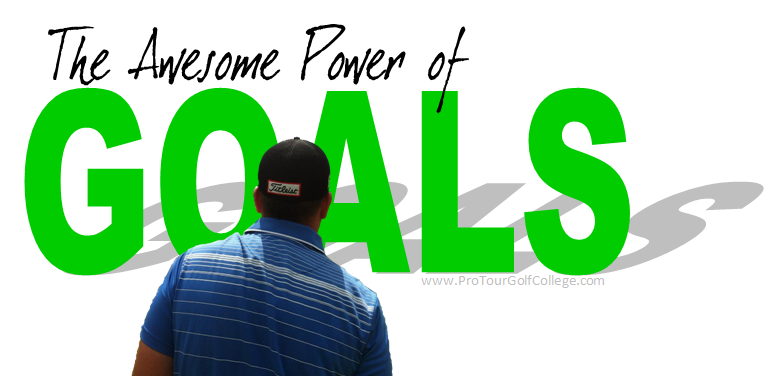
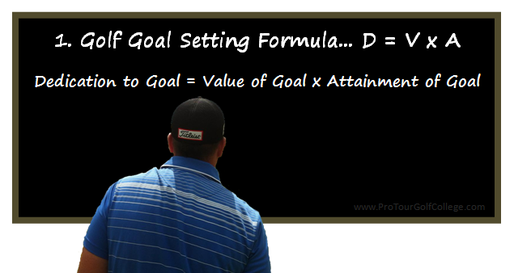
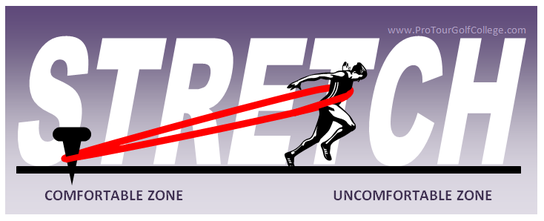
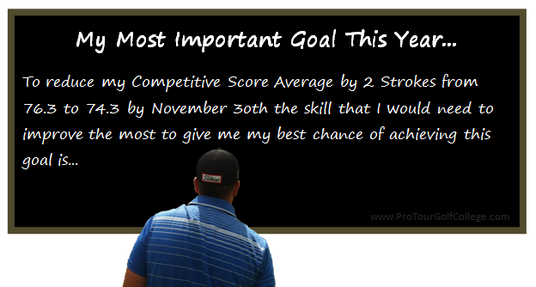
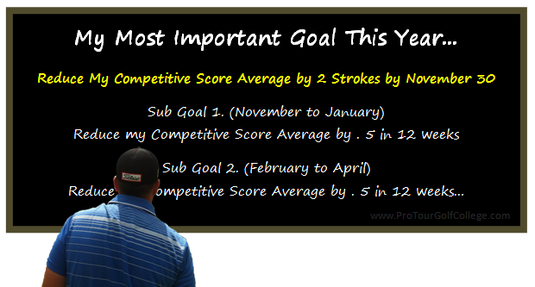

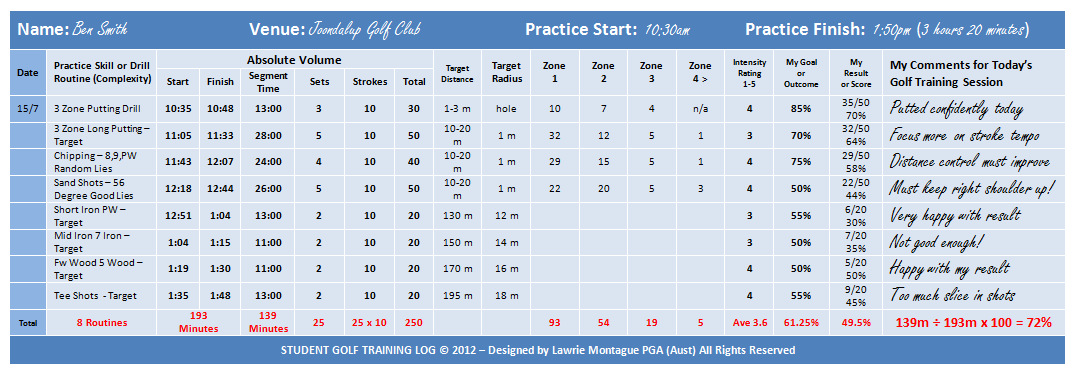


 RSS Feed
RSS Feed



